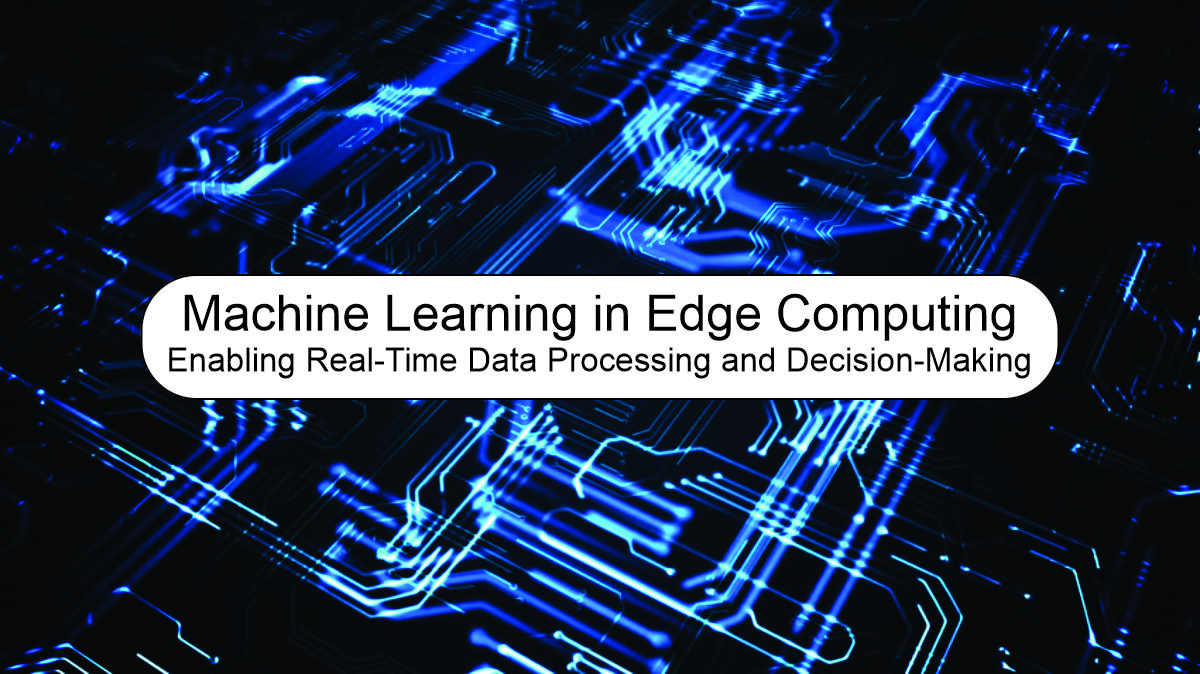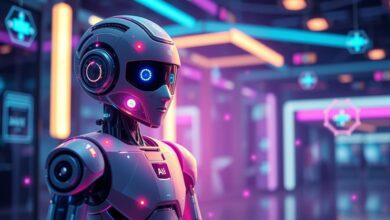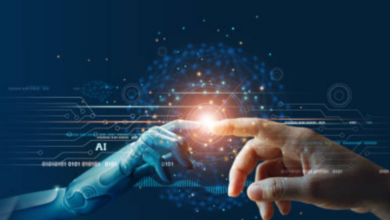Machine Learning in Edge Computing: Enabling Real-Time Data Processing and Decision-Making
Integrating Machine Learning in Edge Computing for Faster Decision-Making and Enhanced Efficiency

Machine learning and edge computing are like best friends. Together, they make our devices smarter and faster. Imagine your phone or a smart toy that can learn new things quickly. This happens because machine learning and edge computing work together. Thus, Machine learning helps devices learn from data. Edge computing helps these devices process this data right where it’s made, not far away on a big computer.
Real-time data processing is significant. It means our devices can make decisions quickly. For example, self-driving cars must decide when to stop or go. It uses machine learning and edge computing to do this fast. It would be too slow if it had to wait for answers from a faraway computer.
The intersection of machine learning and edge computing makes our world better. They work together to make everything faster and smarter. From phones to cars and even smart homes, this teamwork helps us every day. When machines can process data in real time, they make better decisions. This keeps us safe and makes our lives easier.
Understanding how these technologies work is like learning how your favorite game works. It’s fun and exciting! And the best part? This technology keeps getting better. So, get ready for an even smarter future with machine learning and edge computing! If you like this information, share it with your friends. Let’s learn together!
Read Also: Choosing A Database for Machine Learning
Understanding Edge Computing
Edge computing is like having a small computer close to where the data is made. Instead of sending data far away to a big computer, edge computing lets devices like your phone or a smartphone process data right there. This helps them work faster and smarter. Imagine playing a game that never lags because it doesn’t need to wait for a faraway computer to respond.
One key benefit of edge computing is speed. Since the data doesn’t travel far, everything happens much faster. Another benefit is privacy. Your data stays close, so it’s safer. Edge computing also saves bandwidth because it doesn’t need to send lots of information to a central server.
Read Also: Optimize Server Performance with Real-Time Monitoring
There are many cool uses for edge computing. In smart homes, it helps devices like lights and thermostats respond quickly to your commands. In self-driving cars, it processes information from the car’s sensors to make quick decisions, keeping you safe. Even in health, edge computing helps monitor patients in real time, sending alerts if something is wrong.
So, edge computing is a powerful way to make our technology faster, safer, and smarter. It’s like having a tiny helper right there, ready to process information and make decisions quickly. This makes our lives easier and more fun. If you think this is cool, share it with your friends and keep learning together!
Read Also: The Rise of AI: Transforming Business and Daily Life
The Role of Machine Learning in Edge Computing
Machine learning is like teaching computers to learn and make decisions on their own. Just like how you learn from your homework and games, computers learn from data. This makes them smart and able to do tasks without being told exactly what to do each time.
Integrating machine learning with edge computing is very important. It means putting these smart, learning computers close to where the data is made, like in your phone or a smart toy. This way, the device can make decisions quickly without waiting to talk to a big computer far away. For example, your smart watch can learn your fitness patterns and give you instant feedback.
Combining machine learning with edge computing helps in many ways. It makes devices faster and smarter because they can process data right away. It also keeps your information safer since it doesn’t have to travel far. Imagine a self-driving car that can learn and make quick decisions to keep you safe on the road.
So, machine learning and edge computing together are like having a very smart, quick-thinking friend right there with you. This makes your devices more helpful and keeps your data safe and close. If you think this is interesting, tell your friends and keep exploring how technology works!
How Machine Learning Enhances Edge Computing
Machine learning helps edge computing become even smarter and faster. When devices like phones or smartwatches use machine learning, they can process data in real-time. This means they understand and act on information right away, just like how you quickly decide what game to play next.
Real-time data processing is essential. Imagine playing a game where your device learns your moves and gives you tips instantly. This is what happens when machine learning works with edge computing. Devices make better decisions fast, improving their ability to help you in the moment.
Another benefit is improved decision-making. Devices can learn from the data they get and make smart choices. For example, a smart thermostat can learn your favorite room temperature and adjust it without you telling it what to do each time. This makes your life easier and more comfortable.
Reduced latency and bandwidth usage are also key advantages. Latency means delay, and bandwidth is like a highway for data. When data doesn’t have to travel far, it reduces delays and uses less of the data highway. This is important because it means your devices can work faster and more efficiently. For example, a smart home security camera can alert you instantly about any unusual activity without any delay.
Key Technologies and Tools for Machine Learning at the Edge
Machine learning at the edge uses special tools and devices to make our gadgets smarter right where we use them. Let’s explore the cool things that make it all work!
Edge Devices and Hardware
Edge devices are like the brains of our smart gadgets. They make decisions and learn things without needing to connect to a big computer far away. These devices are small but powerful, like the computer chips in our toys that make them talk and move on their own.
Popular Edge Computing Platforms
Edge computing platforms help our gadgets work together and learn from each other. Here are some of the popular ones:
AWS IoT Greengrass
AWS IoT Greengrass helps gadgets like our toys or home devices talk to each other and learn new things. It’s like a team of robots that share what they learn without telling all their secrets.
Azure IoT Edge
Azure IoT Edge is like a super brain for our gadgets. It helps them make decisions faster, like knowing when to turn off a light or play their favorite song. It’s smart and keeps our secrets safe.
Google Edge TPU
Google Edge TPU makes our gadgets super fast. It’s like giving our toys a turbo boost so they can do more things in less time. It helps them learn quickly and do cool tricks without slowing down.
Read Also: The Internet of Things (IoT): Connecting Everyday Objects to the Internet
Machine Learning Frameworks for Edge Computing
Machine learning frameworks are like special tools that help our gadgets learn new things. Here are some that make our gadgets smart:
TensorFlow Lite
TensorFlow Lite is like a magic wand for our gadgets. It helps them learn and understand things around them, like telling colors or recognizing our voices. It’s smart and makes learning fun!
OpenVINO
OpenVINO helps gadgets see and understand things quickly. It’s like giving them superhero eyes that can see in the dark or tell us who’s at the door. It’s cool and keeps us safe.
Edge Impulse
Edge Impulse helps gadgets learn from what they see and hear. It’s like teaching our toys to play games and make music. It’s fun and makes our gadgets even smarter!
These tools and gadgets make machine learning at the edge amazing. They help our toys, home devices, and even cars learn and do cool things without needing help from far away.
Implementing Machine Learning at the Edge
Implementing machine learning at the edge is like teaching your smart devices new tricks. First, the devices collect data, like a smartwatch counting your steps. This data needs to be cleaned and prepared, which is called preprocessing. Think of it like getting your toys ready before playing a game.
Next, the devices learn from the data through a process called model training. This is when the device figures out patterns and becomes smarter. Once the model is trained, it gets deployed, which means it starts working on the device, helping it make better decisions, like predicting when you need a break after playing.
But the learning doesn’t stop there. Devices keep learning through continuous learning and model updates. They get better over time, just like you get better at your favorite game the more you play it. The device updates its model to stay smart and helpful.
However, there are some challenges. One big challenge is making sure the data is good quality. If the data is messy, the device can’t learn well. Another challenge is training the model efficiently without using too much power. It’s like trying to play a game without running out of battery. Finally, keeping the device secure and protecting your data is crucial.
Applications of Machine Learning in Edge Computing
Machine learning in edge computing is like giving smart brains to gadgets right where they are. This helps them work faster and smarter without waiting for help from faraway computers. These smart gadgets can do many cool things in different areas.
They help factories work better, make cities safer, keep us healthy, and even improve our shopping and driving experiences. Let’s explore how machine learning and edge computing work together in these exciting ways!
Industrial IoT and Predictive Maintenance
In factories, machines work hard every day. Sometimes, they break down, causing problems. Machine learning helps by predicting when a machine might need fixing before it breaks. This is called predictive maintenance. Smart sensors on the machines collect data, and machine learning analyzes it. This way, factory workers know when to fix machines and can prevent big problems.
Smart Cities and Traffic Management
Cities can be very busy with lots of cars and people. Machine learning helps manage traffic better. Sensors and cameras collect data on the roads. Machine learning then analyzes this data to control traffic lights and reduce traffic jams. This makes driving smoother and safer for everyone. Smart cities use this technology to keep things running smoothly.
Healthcare and Remote Monitoring
Doctors can’t always be with their patients, but smart devices can help. In healthcare, machine learning in edge computing allows doctors to monitor patients from far away.
Devices like heart monitors collect data and send it to doctors. Machine learning analyzes the data and alerts doctors if something is wrong. This keeps patients safe and healthy, even when they are at home.
Retail and Customer Experience Enhancement
Shopping can be more fun and personalized with machine learning. Stores use sensors to see what products people like. Machine learning analyzes this data to offer better recommendations and special offers. This way, customers find what they want faster and enjoy their shopping experience more. It’s like having a personal shopper who knows exactly what you like!
Autonomous Vehicles and Drones
Self-driving cars and flying drones are super cool. They use machine learning to understand their surroundings and make decisions. Sensors on the vehicles collect data about the road and air. Machine learning processes this data in real time to avoid obstacles and follow the best path. This makes autonomous vehicles and drones safe and efficient.
Challenges and Solutions in Machine Learning for Edge Computing
Machine learning in edge computing is super smart, but it also faces some challenges. These challenges are like tricky puzzles that need solving to make everything work perfectly. Let’s explore these challenges and their solutions so that our smart gadgets can keep getting smarter!
Machine learning in edge computing has to be safe and secure. Here’s how we tackle the challenges:
Ensuring Data Privacy and Security
- Challenge: Keeping data safe from bad people who might try to steal it.
- Solution: Using strong encryption and special codes to protect data from being seen by anyone who shouldn’t.
Managing Limited Computational Resources
- Challenge: Make sure smart gadgets don’t run out of power while doing smart things.
- Solution: Design smart software that uses less power and works faster without needing too much energy.
Handling Diverse and Noisy Data
- Challenge: Dealing with data that might be messy or not clear, like when it’s hard to understand someone talking loudly.
- Solution: Using special algorithms that can understand messy data and still make smart decisions.
Achieving Interoperability Across Devices
- Challenge: Make sure all different gadgets can talk to each other and work together.
- Solution: Create standards and rules that all gadgets follow so they can understand each other and share information easily.
Future Trends in Machine Learning at the Edge
Machine learning is getting super smart, especially when it’s at the edge of our devices. Here’s what’s coming next:
- Advances in Hardware Capabilities: Smart gadgets are going to get even faster and stronger. This means they can do more complicated tasks without slowing down.
- Increasing Adoption of Federated Learning: Imagine if lots of gadgets work together to learn things. Federated learning lets them do this without sharing their secrets. It’s like a big team where everyone helps without knowing all the details.
- Growth of 5G and Its Impact on Edge Computing: 5G is like super-fast internet for our gadgets. It helps them talk to each other quickly, which means they can make decisions faster and do things in real time.
- Emerging Use Cases and Innovations: We’ll see smart gadgets helping in new ways, like making cities safer or helping doctors in hospitals. There will be new ideas and inventions that make our lives easier and more fun.
These trends show that machine learning at the edge is going to change how we use technology. It will make our gadgets smarter and our lives better. Exciting times are ahead!
Conclusion
Now you know how machine learning and edge computing work together to make our gadgets super smart! They help toys, home devices, and even cars learn and do cool things without needing help from far away. Remember, edge computing helps our gadgets make quick decisions, like turning on a light when it gets dark. It’s like having a superhero brain right inside our toys!
Machine learning and edge computing are making our world safer and more fun. What do you think about these amazing technologies? Share your thoughts in the comments below and tell your friends about how edge computing is changing our gadgets. Let’s embrace the future of edge intelligence together!








